农产品供应链管理【外文翻译】
- 格式:doc
- 大小:58.00 KB
- 文档页数:9
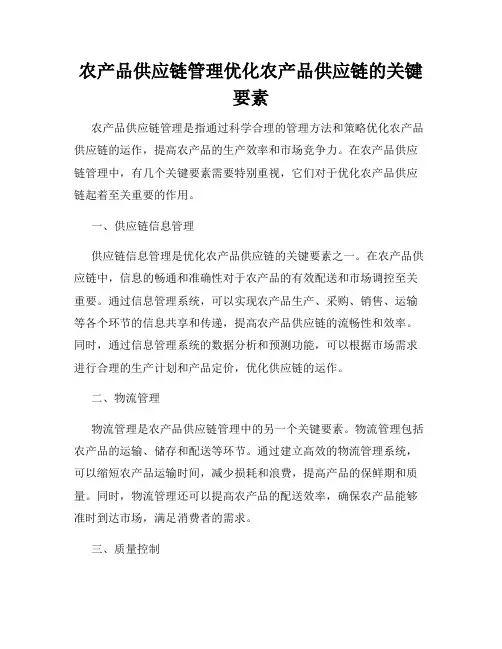
农产品供应链管理优化农产品供应链的关键要素农产品供应链管理是指通过科学合理的管理方法和策略优化农产品供应链的运作,提高农产品的生产效率和市场竞争力。
在农产品供应链管理中,有几个关键要素需要特别重视,它们对于优化农产品供应链起着至关重要的作用。
一、供应链信息管理供应链信息管理是优化农产品供应链的关键要素之一。
在农产品供应链中,信息的畅通和准确性对于农产品的有效配送和市场调控至关重要。
通过信息管理系统,可以实现农产品生产、采购、销售、运输等各个环节的信息共享和传递,提高农产品供应链的流畅性和效率。
同时,通过信息管理系统的数据分析和预测功能,可以根据市场需求进行合理的生产计划和产品定价,优化供应链的运作。
二、物流管理物流管理是农产品供应链管理中的另一个关键要素。
物流管理包括农产品的运输、储存和配送等环节。
通过建立高效的物流管理系统,可以缩短农产品运输时间,减少损耗和浪费,提高产品的保鲜期和质量。
同时,物流管理还可以提高农产品的配送效率,确保农产品能够准时到达市场,满足消费者的需求。
三、质量控制质量控制是优化农产品供应链不可或缺的要素。
农产品的质量和安全是消费者购买的重要考量因素,也是农产品供应链管理的核心内容之一。
通过建立科学的质量控制体系和检验标准,可以确保农产品的质量和安全符合国家的相关规定和标准。
同时,还可以加强农产品的追溯体系,提高产品的可追溯性,增加消费者对农产品的信任和认可度。
四、合作伙伴关系管理合作伙伴关系管理是农产品供应链管理中的重要要素。
农产品供应链中的各个环节需要多个参与方的合作与协同,只有加强与各个合作伙伴的合作关系,才能够实现供应链的高效运作。
通过建立稳定的合作伙伴关系,可以实现资源共享和风险共担,提高供应链的协同效应和市场竞争力。
五、政策支持政策支持是农产品供应链管理的基础和保障。
政府部门应当出台相关的政策法规,加强对农产品供应链管理的支持和指导。
政策支持可以包括财政和税收优惠、科技创新和资源优化等方面,为农产品供应链管理提供必要的支持和保护。
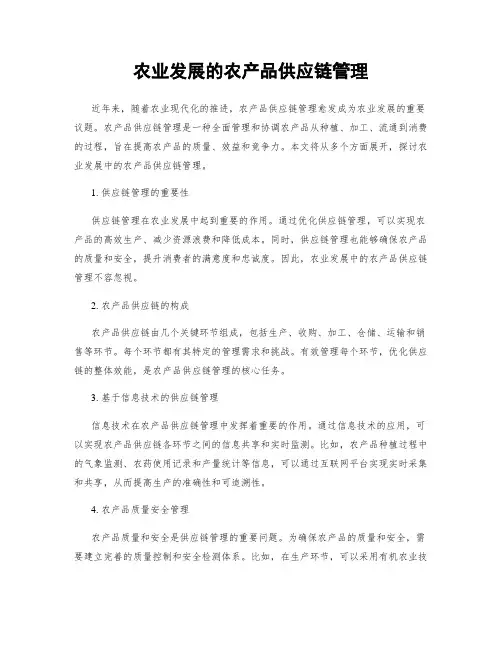
农业发展的农产品供应链管理近年来,随着农业现代化的推进,农产品供应链管理愈发成为农业发展的重要议题。
农产品供应链管理是一种全面管理和协调农产品从种植、加工、流通到消费的过程,旨在提高农产品的质量、效益和竞争力。
本文将从多个方面展开,探讨农业发展中的农产品供应链管理。
1. 供应链管理的重要性供应链管理在农业发展中起到重要的作用。
通过优化供应链管理,可以实现农产品的高效生产、减少资源浪费和降低成本。
同时,供应链管理也能够确保农产品的质量和安全,提升消费者的满意度和忠诚度。
因此,农业发展中的农产品供应链管理不容忽视。
2. 农产品供应链的构成农产品供应链由几个关键环节组成,包括生产、收购、加工、仓储、运输和销售等环节。
每个环节都有其特定的管理需求和挑战。
有效管理每个环节,优化供应链的整体效能,是农产品供应链管理的核心任务。
3. 基于信息技术的供应链管理信息技术在农产品供应链管理中发挥着重要的作用。
通过信息技术的应用,可以实现农产品供应链各环节之间的信息共享和实时监测。
比如,农产品种植过程中的气象监测、农药使用记录和产量统计等信息,可以通过互联网平台实现实时采集和共享,从而提高生产的准确性和可追溯性。
4. 农产品质量安全管理农产品质量和安全是供应链管理的重要问题。
为确保农产品的质量和安全,需要建立完善的质量控制和安全检测体系。
比如,在生产环节,可以采用有机农业技术和绿色农业标准,减少化肥农药的使用;在加工环节,应严格遵守食品安全法律法规,确保产品品质和卫生安全。
5. 运输与仓储管理农产品的运输与仓储环节是供应链管理中至关重要的环节。
合理安排运输路线和运输方式,能够降低物流成本和损耗。
同时,科学规划仓储设施和货物储存,能够保证农产品质量和新鲜度,确保及时供应市场。
6. 终端销售与市场营销终端销售与市场营销是供应链管理中的最后一环。
通过有效的市场分析和品牌推广,可以提高农产品的竞争力和附加值。
农产品供应链管理需要注重市场需求的了解和品牌建设,以满足消费者的需求和提升产品价值。
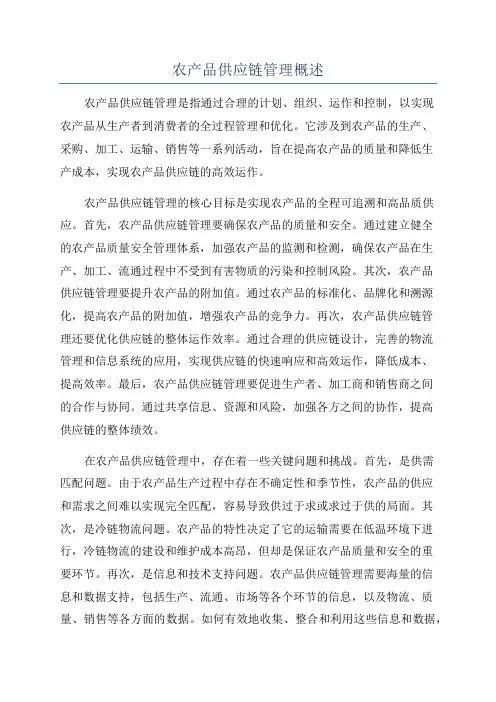
农产品供应链管理概述农产品供应链管理是指通过合理的计划、组织、运作和控制,以实现农产品从生产者到消费者的全过程管理和优化。
它涉及到农产品的生产、采购、加工、运输、销售等一系列活动,旨在提高农产品的质量和降低生产成本,实现农产品供应链的高效运作。
农产品供应链管理的核心目标是实现农产品的全程可追溯和高品质供应。
首先,农产品供应链管理要确保农产品的质量和安全。
通过建立健全的农产品质量安全管理体系,加强农产品的监测和检测,确保农产品在生产、加工、流通过程中不受到有害物质的污染和控制风险。
其次,农产品供应链管理要提升农产品的附加值。
通过农产品的标准化、品牌化和溯源化,提高农产品的附加值,增强农产品的竞争力。
再次,农产品供应链管理还要优化供应链的整体运作效率。
通过合理的供应链设计,完善的物流管理和信息系统的应用,实现供应链的快速响应和高效运作,降低成本、提高效率。
最后,农产品供应链管理要促进生产者、加工商和销售商之间的合作与协同。
通过共享信息、资源和风险,加强各方之间的协作,提高供应链的整体绩效。
在农产品供应链管理中,存在着一些关键问题和挑战。
首先,是供需匹配问题。
由于农产品生产过程中存在不确定性和季节性,农产品的供应和需求之间难以实现完全匹配,容易导致供过于求或求过于供的局面。
其次,是冷链物流问题。
农产品的特性决定了它的运输需要在低温环境下进行,冷链物流的建设和维护成本高昂,但却是保证农产品质量和安全的重要环节。
再次,是信息和技术支持问题。
农产品供应链管理需要海量的信息和数据支持,包括生产、流通、市场等各个环节的信息,以及物流、质量、销售等各方面的数据。
如何有效地收集、整合和利用这些信息和数据,需要借助先进的信息技术和管理工具。
最后,是风险管理问题。
农产品供应链管理涉及到供应商、生产者、加工商、运输商、销售商等多个环节和多个主体,其中存在着众多的风险,如天气灾害、市场变动、商品质量问题等。
如何预测和处理这些风险,需要定期进行风险评估和制定相应的应对策略。
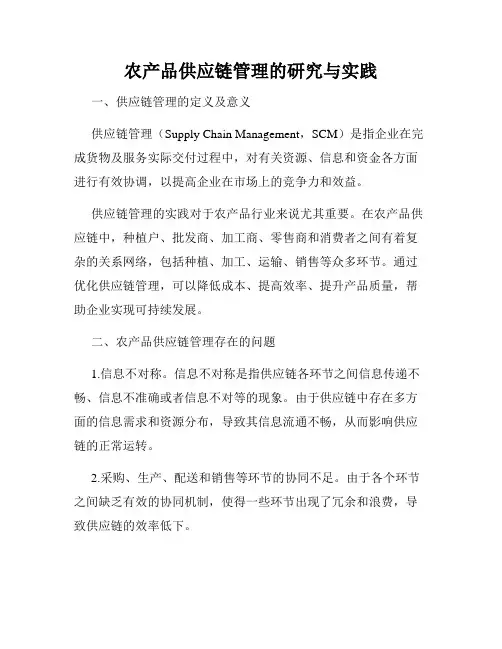
农产品供应链管理的研究与实践一、供应链管理的定义及意义供应链管理(Supply Chain Management,SCM)是指企业在完成货物及服务实际交付过程中,对有关资源、信息和资金各方面进行有效协调,以提高企业在市场上的竞争力和效益。
供应链管理的实践对于农产品行业来说尤其重要。
在农产品供应链中,种植户、批发商、加工商、零售商和消费者之间有着复杂的关系网络,包括种植、加工、运输、销售等众多环节。
通过优化供应链管理,可以降低成本、提高效率、提升产品质量,帮助企业实现可持续发展。
二、农产品供应链管理存在的问题1.信息不对称。
信息不对称是指供应链各环节之间信息传递不畅、信息不准确或者信息不对等的现象。
由于供应链中存在多方面的信息需求和资源分布,导致其信息流通不畅,从而影响供应链的正常运转。
2.采购、生产、配送和销售等环节的协同不足。
由于各个环节之间缺乏有效的协同机制,使得一些环节出现了冗余和浪费,导致供应链的效率低下。
3.物流配送效率低下。
受限于农村基础设施和物流条件的限制,农产品运输、配送过程中存在较大的浪费和损失,主要表现在货物滞留、库存过多、损耗严重等问题。
三、优化农产品供应链管理的方法1.加强信息共享。
通过建立信息共享平台和信息化技术应用,确保供应链各环节之间信息流通无障碍、信息准确。
2.优化采购、生产、配送和销售等环节的协同机制。
实现各个环节之间协同,减少重复的工作和流程,提高效率。
3.提升物流配送效率。
实行定期保养货车和仓库设施,优化物流配送线路,提供可靠的物流服务,降低物流成本,提高效率。
四、供应链金融的实践随着金融科技的发展,供应链金融得以快速发展。
通过融资、票据贴现、期货、保险等金融工具的运用,可以快速解决供应链中的资金问题,提高供应链的流动性,促进供应链各方合作和信任。
五、农产品供应链管理的案例分析1.盐城魔芋供应链管理。
盐城魔芋产业通过建立信息平台、配合植物检疫部门和运输单位,优化物流配送,加快退换货速度,节省了大量时间和成本,提高了客户满意度和销售额。
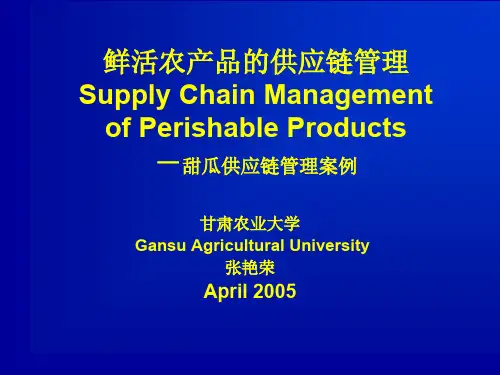
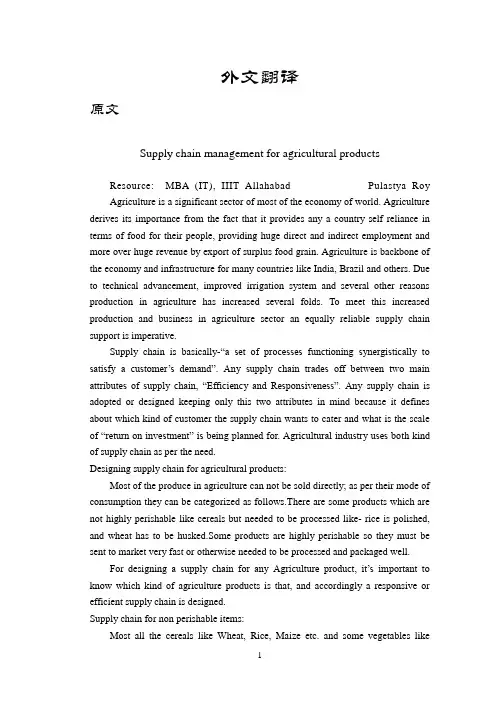
外文翻译原文Supply chain management for agricultural productsResource: MBA (IT), IIIT Allahabad Pulastya Roy Agriculture is a significant sector of most of the economy of world. Agriculture derives its importance from the fact that it provides any a country self reliance in terms of food for their people, providing huge direct and indirect employment and more over huge revenue by export of surplus food grain. Agriculture is backbone of the economy and infrastructure for many countries like India, Brazil and others. Due to technical advancement, improved irrigation system and several other reasons production in agriculture has increased several folds. To meet this increased production and business in agriculture sector an equally reliable supply chain support is imperative.Supply chain is basically-“a set of processes functioning synergistically to satisfy a customer’s demand”. Any supply chain trades off between two main attributes of supply chain, “Efficiency and Responsiveness”. Any supply chain is adopted or designed keeping only this two attributes in mind because it defines about which kind of customer the supply chain wants to cater and what is the scale of “return on investment” is being planned for. Agricultural industry uses bo th kind of supply chain as per the need.Designing supply chain for agricultural products:Most of the produce in agriculture can not be sold directly; as per their mode of consumption they can be categorized as follows.There are some products which are not highly perishable like cereals but needed to be processed like- rice is polished, and wheat has to be husked.Some products are highly perishable so they must be sent to market very fast or otherwise needed to be processed and packaged well.For designing a supply chain for any Agriculture product, it’s important to know which kind of agriculture products is that, and accordingly a responsive or efficient supply chain is designed.Supply chain for non perishable items:Most all the cereals like Wheat, Rice, Maize etc. and some vegetables likePotato and Onion are highly inelastic in demand, moreover they are not highly perishables so the supply chain for such products should focus more on efficiency and cost effectiveness than responsiveness. These products have vital supply and demand links with the market. Cereals needs some kind of processing and polishing after they are harvested from field and from here onwards supply chain comes into play. The food grain is then packed in jute bags and then stored in cold storages till they get order from market.These type of agricultural products are highly in elastic in demand and the demand more or less remains constant so their demand can easily be forecasted and hence while designing supply chain for such products efficiency should be more preferred.Supply chain for perishable items:Fruits, green vegetables and flower come under perishable items and they need all together a more responsive, fast and accountable supply chain as a means of propagation from farms to the market.These products are elastic and erratic in demand hence their demand forecasting is also difficult. They need more costly type cold storage and refrigeration, special transportation mechanism and on time delivery, all these requirements make this supply chain very costly, but at the same time the price of these products are consummately adjusted to ensure higher margin and profit. While designing supply chain for such items main focus should be given on the responsiveness.Supply chain management for fruits:To handle supply chain for these items is a very demanding task. Such products need facilities like refrigerated vans, more efficient cold storage faster transportation. This is the sector where India needs more improvement. India is the second largest producer for both fruits and vegetables, next only to China. Major vegetables include potato, eggplants, tomatoes, cassava, cabbage, dry onions, cauliflower, pumpkin, okra and green peas, while fruits include mangoes, oranges, apples, grapes, pineapples and papaya. So we severely need better support system to handle this massive produce. For example refrigerated vans, the need for refrigerated vans is driven by economics. Every year, India wastes over 30 per cent of the fruits and vegetables owing to shortage of proper cold chain infrastructure. As of today, most of the fruits and vegetables and meat get spoilt by the time they are transported from the farmlands to the retail chains in the cities. The export potential of fresh fruits,vegetables and dairy sector in India has not been fully tapped considering the size and diversity of these sectors. A poor supply chain is a chief reason behind this. However, India has a negligible share in imports of fruits and vegetables by countries like Australia, Hong Kong, Indonesia, Iran, Japan, Jordan, Republic of Korea, Lebanon, Mongolia, New Zealand, Pakistan, Philippines, Singapore, Syria and Thailand. Considering the level of imports in Asian countries, the study noted that India has a high potential in many Asian markets. Potential fruits identified by the study for increasing the exports include apples, oranges, bananas, watermelon, mandarin, pineapple, mangoes and guavas. Potential vegetables identified by the study include garlic, cauliflower, tomatoes, potatoes, cucumbers, peas, mushrooms, onions and eggplants.Major problems for fresh fruit and vegetable exports from India include low productivity (cost competitiveness) as compared to global standards, prevalence of a low level of pre-harvest and post-harvest technologies, international quality standards and existence of distortion in market channels and poor supply chain system. Developing region specific export facilitation centers and emphasizing the role of Agri-Export Zones (AEZs) further in tandem with the market requirements, especially to provide a specific thrust to the quality and supply chain requirements of the target markets.A case introduction about the main application technology in Japan Fresh Logistics:In order to maintain the freshness of agricultural products, need to form different products and flow characteristics of the harvest, transport, storage, logistics links the integrated use of various types of technology.(A) the cold chain system is the core of logistics technology, preservation of agricultural products, mainly involving pre-cooling, freezing refrigerated transportation and warehousing sectors insulation.1. Precooling means immediately after the harvest of agricultural products for rapid cooling of their processing, treatment can be controlled by pre-cooling products, respiration and evaporation to prevent the organic acids, Victoria C, etc. to reduce nutrients, inhibit bacterial growth in order to achieve the maintenance of product color, anti-corrosion and to prevent overripe fruit and other fresh-keeping effect. The pre-cooling is more popular in Japan that the main mode are as follows:(1) forced ventilation pre-cooling: to pre-cooling bank chilling by cold air for cooling. Construction costs low, can be applied to wider variety of agricultural industries, but the cooling process more time-consuming, non-uniform cooling.(2) differential pressure ventilation pre-cooling: In the manufacture of pressure difference on both sides of the container, to instill air-conditioning inside the container. Construction costs in the forced ventilation between the pre-cooling and vacuum pre-cooling. Forced ventilation cooling rate faster than the pre-cooling, and the cooling effect of uniform, but some agricultural products so that method has been applied will be sent fade. When loading takes some time.(3) Vacuum precooling: The agricultural products into the decompression chamber, promoting the internal water evaporation, thus cooling. The cooling speed, the effect is even, but not frozen bulky, surface area of small fruit. Higher construction costs, more was necessary to build cold storage.(4) cold-water pre-cooling: to pour cold water on agricultural products, or to soak them in refrigeration. Cool faster, but not suitable for soaking the product can not be more need for a separate cold storage building.2. Frozen refrigerated transport is an important component of cold chain system, mainly involving insulation trucks, containers and incubator technology. Japan is now the majority of perishable agricultural products have been the vast majority of the use of heat insulation container transport trucks and some high-end agricultural products by air to shorten the circulation time. Such as the early morning harvest fish, high-grade fruits, the day will be able to appear in Tokyo department stores on the counter.(B) preservation, and packagingAccording to different product characteristics and circulation patterns, use of appropriate preservation, and packaging technologies. Of potatoes, onions and other non-perishable vegetables, etc. can take a simple packaging, through the air circulation inside the container can control the mildew and rot. And to maximize the size of the transport and improve transport efficiency, bringing the cost advantages of scale. Order online or mail order and other small-scale circulation of agricultural products, the use of foam packaging plus refrigerated cooling agent. Pairs of high-valued agricultural products can be taken to special packaging. Such as Japan in the cherry, peach, strawberry and other fruit on the packaging of easily bruised widespread use of buffering materials, and the use of special preservation tank to absorb the ethylene composition distribution of fruit and control fruit had cooked. In addition, with refrigerated transport, and sometimes need to use foam packaging, the package straight refrigerants.Used for multiple recycling of the transport containers can effectively improvethe transportation efficiency, reduce transportation costs. Japan, the transport of agricultural products widely used standard-size folding transport case, a transportation overlay when placed after the discharge of folding up the transport do not take up space, and can be recycled many times.(C) fresh storageFrozen fresh storage warehouse is the foundation, in addition to a number of recent Refrigeration technology began with the promotion, the more popular two methods are as follows:Controlled atmosphere storage (controlled atmosphere, referred to as CA storage): the use of nitrogen or carbon dioxide to inhibit respiration in order to achieve fresh results.Dried Preserved: The natural drying or artificial drying, raw materials for food or food dehydration, so water does not result in reduced to the extent of food spoilage, so as to achieve the purpose of preservation.Conclusion:Agriculture is the main stay of the Indian and several other economies of world, it constitutes the backbone of rural livelihood security system and accounts for a handsome percent of GDP of the whole world and if given due support to this industry in terms of better supply chain management system it can certainly provide India or in that manner any agricultural based economy a substantial growth.译文农产品供应链管理来源:工商管理硕士(信息技术),印度国际信息学院,阿拉哈巴德.罗伊农业是世界经济中一个最重要的部门。
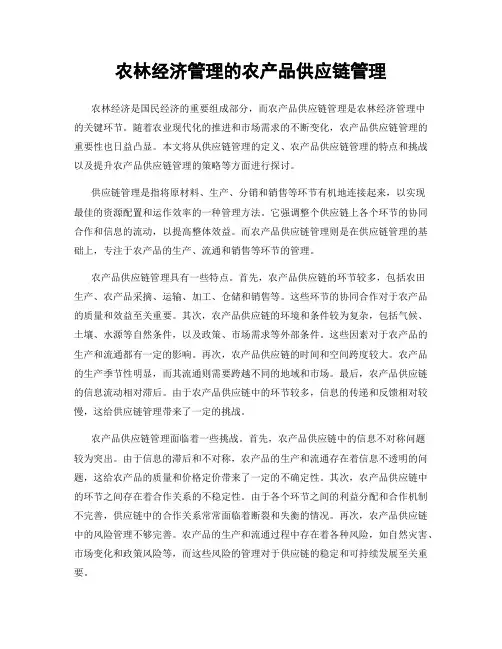
农林经济管理的农产品供应链管理农林经济是国民经济的重要组成部分,而农产品供应链管理是农林经济管理中的关键环节。
随着农业现代化的推进和市场需求的不断变化,农产品供应链管理的重要性也日益凸显。
本文将从供应链管理的定义、农产品供应链管理的特点和挑战以及提升农产品供应链管理的策略等方面进行探讨。
供应链管理是指将原材料、生产、分销和销售等环节有机地连接起来,以实现最佳的资源配置和运作效率的一种管理方法。
它强调整个供应链上各个环节的协同合作和信息的流动,以提高整体效益。
而农产品供应链管理则是在供应链管理的基础上,专注于农产品的生产、流通和销售等环节的管理。
农产品供应链管理具有一些特点。
首先,农产品供应链的环节较多,包括农田生产、农产品采摘、运输、加工、仓储和销售等。
这些环节的协同合作对于农产品的质量和效益至关重要。
其次,农产品供应链的环境和条件较为复杂,包括气候、土壤、水源等自然条件,以及政策、市场需求等外部条件。
这些因素对于农产品的生产和流通都有一定的影响。
再次,农产品供应链的时间和空间跨度较大。
农产品的生产季节性明显,而其流通则需要跨越不同的地域和市场。
最后,农产品供应链的信息流动相对滞后。
由于农产品供应链中的环节较多,信息的传递和反馈相对较慢,这给供应链管理带来了一定的挑战。
农产品供应链管理面临着一些挑战。
首先,农产品供应链中的信息不对称问题较为突出。
由于信息的滞后和不对称,农产品的生产和流通存在着信息不透明的问题,这给农产品的质量和价格定价带来了一定的不确定性。
其次,农产品供应链中的环节之间存在着合作关系的不稳定性。
由于各个环节之间的利益分配和合作机制不完善,供应链中的合作关系常常面临着断裂和失衡的情况。
再次,农产品供应链中的风险管理不够完善。
农产品的生产和流通过程中存在着各种风险,如自然灾害、市场变化和政策风险等,而这些风险的管理对于供应链的稳定和可持续发展至关重要。
为了提升农产品供应链管理,可以采取一些策略。
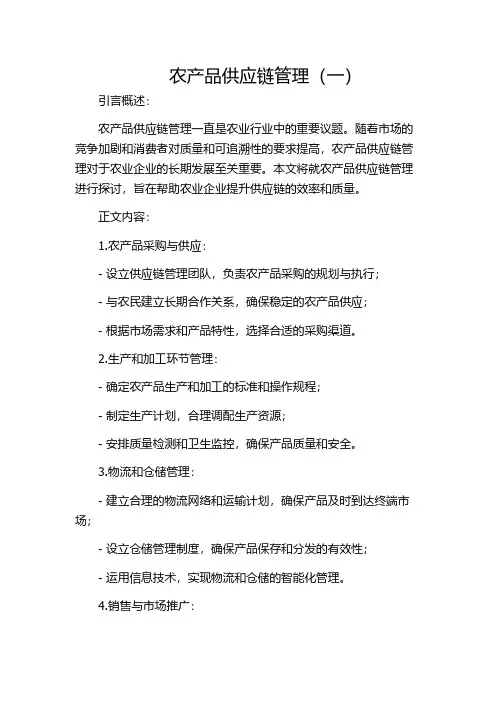
农产品供应链管理(一)引言概述:农产品供应链管理一直是农业行业中的重要议题。
随着市场的竞争加剧和消费者对质量和可追溯性的要求提高,农产品供应链管理对于农业企业的长期发展至关重要。
本文将就农产品供应链管理进行探讨,旨在帮助农业企业提升供应链的效率和质量。
正文内容:1.农产品采购与供应:- 设立供应链管理团队,负责农产品采购的规划与执行;- 与农民建立长期合作关系,确保稳定的农产品供应;- 根据市场需求和产品特性,选择合适的采购渠道。
2.生产和加工环节管理:- 确定农产品生产和加工的标准和操作规程;- 制定生产计划,合理调配生产资源;- 安排质量检测和卫生监控,确保产品质量和安全。
3.物流和仓储管理:- 建立合理的物流网络和运输计划,确保产品及时到达终端市场;- 设立仓储管理制度,确保产品保存和分发的有效性;- 运用信息技术,实现物流和仓储的智能化管理。
4.销售与市场推广:- 根据市场需求,制定销售计划和市场推广策略;- 建立与零售商和批发商的合作关系,拓展销售渠道;- 加强品牌建设和宣传,提升产品的知名度和口碑。
5.售后服务和客户关系管理:- 设立售后服务团队,及时解决客户反馈的问题和投诉;- 建立客户关系管理系统,定期与客户保持联系,了解市场需求;- 建立客户数据库,为后续营销活动提供有效支持。
总结:通过有效的农产品供应链管理,农业企业可实现从农产品生产到销售的全面管理与控制。
在采购、生产、物流、销售和售后服务等环节,通过合理规划、精细操作和信息技术应用,企业能够提升供应链的效率和质量,满足消费者对农产品质量和可追溯性的需求,从而获得竞争优势。
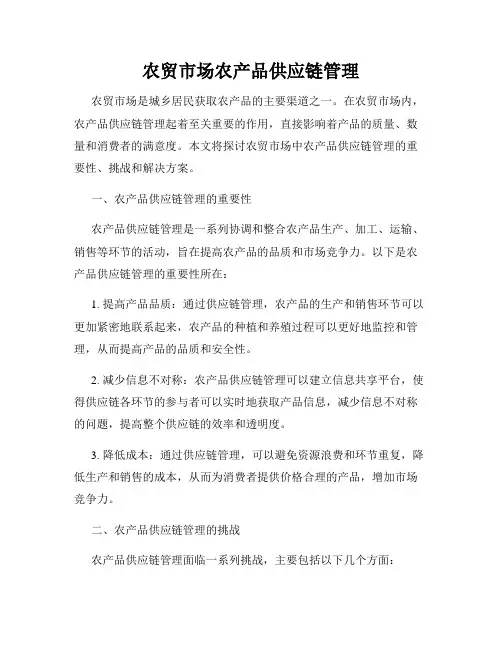
农贸市场农产品供应链管理农贸市场是城乡居民获取农产品的主要渠道之一。
在农贸市场内,农产品供应链管理起着至关重要的作用,直接影响着产品的质量、数量和消费者的满意度。
本文将探讨农贸市场中农产品供应链管理的重要性、挑战和解决方案。
一、农产品供应链管理的重要性农产品供应链管理是一系列协调和整合农产品生产、加工、运输、销售等环节的活动,旨在提高农产品的品质和市场竞争力。
以下是农产品供应链管理的重要性所在:1. 提高产品品质:通过供应链管理,农产品的生产和销售环节可以更加紧密地联系起来,农产品的种植和养殖过程可以更好地监控和管理,从而提高产品的品质和安全性。
2. 减少信息不对称:农产品供应链管理可以建立信息共享平台,使得供应链各环节的参与者可以实时地获取产品信息,减少信息不对称的问题,提高整个供应链的效率和透明度。
3. 降低成本:通过供应链管理,可以避免资源浪费和环节重复,降低生产和销售的成本,从而为消费者提供价格合理的产品,增加市场竞争力。
二、农产品供应链管理的挑战农产品供应链管理面临一系列挑战,主要包括以下几个方面:1. 信息不对称:农产品供应链中的各个环节往往信息不对称,生产者无法准确了解市场需求,而消费者也很难获得农产品的真实信息。
信息不对称导致供需失衡,影响供应链的运作效率和产品质量。
2. 产品流通环节长:由于农产品的产地常常在城市外围,产品流通过程较长,易受到气候和运输等因素的影响,增加了供应链的复杂性和管理难度。
3. 产品质量控制难:农产品的质量受到生产环境、种植技术和加工方式等多个因素的影响,如何确保产品质量一直是农产品供应链管理的难点之一。
三、农产品供应链管理的解决方案为了有效管理和优化农产品供应链,以下是一些解决方案的提出:1. 建立信息共享平台:通过建立统一的信息平台,实现供应链各环节的信息共享,消除信息不对称,提高供应链的协同效应,减少资源浪费。
2. 强化质量管理:加强对农产品种植和养殖过程的监督和管理,确保产品的质量和安全性。
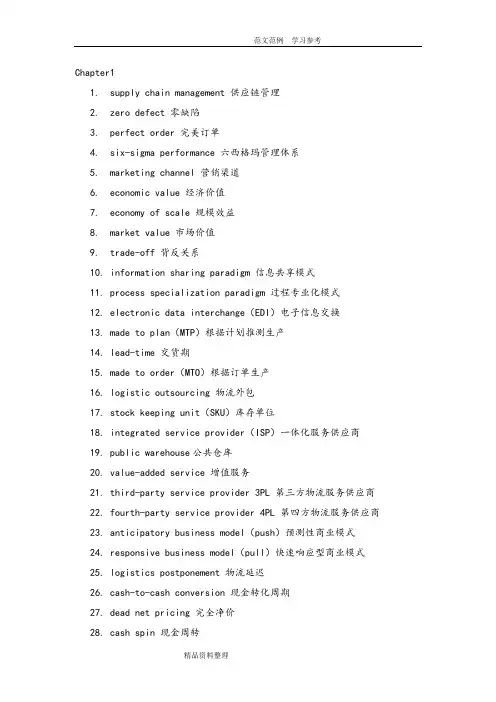
Chapter11.supply chain management 供应链管理2.zero defect 零缺陷3.perfect order 完美订单4.six-sigma performance 六西格玛管理体系5.marketing channel 营销渠道6.economic value 经济价值7.economy of scale 规模效益8.market value 市场价值9.trade-off 背反关系rmation sharing paradigm 信息共享模式11.process specialization paradigm 过程专业化模式12.electronic data interchange(EDI)电子信息交换13.made to plan(MTP)根据计划推测生产14.lead-time 交货期15.made to order(MTO)根据订单生产16.logistic outsourcing 物流外包17.stock keeping unit(SKU)库存单位18.integrated service provider(ISP)一体化服务供应商19.public warehouse公共仓库20.value-added service 增值服务21.third-party service provider 3PL 第三方物流服务供应商22.fourth-party service provider 4PL 第四方物流服务供应商23.anticipatory business model(push)预测性商业模式24.responsive business model(pull)快速响应型商业模式25.logistics postponement 物流延迟26.cash-to-cash conversion 现金转化周期27.dead net pricing 完全净价28.cash spin 现金周转29.operational performance 运作绩效30.order processing 订单处理31.customer accommodation 市场分销Chapter2 Inbound logistics 采购运筹,进口物流1.Procurement perspective and strategies 采购远景和策略2.continuous supply 持续供应3.minimize inventory investment 减少存货投资-JIT4.quality improvement 质量改进5.lowest total cost of ownership-TCO 所有权总成本最低6.supplier-buyer integration 供方买方整合7.value management 价值管理8.sales synergy 销售协同9.Manufacturing perspective and strategies 生产远景和策略10.brand power 品牌力11.Lead time 备货期12.Make-to-stock(MTS)备货型生产13.Make-to-order(MTO)订货型生产14.Assemble-to-order(ATO)面向订单装配15.Material Requirement Planning(MRP) 物料需求计划Chapter3 Outbound Logistics 出货物流1.Supply chain service output 供应链营运功率2.Spatial convenience 空间便利性3.Lot size 批量4.Waiting time 等待时间5.Stock out frequency 缺货率6.Fill rate 供应比率7. Sales and operations planning 销售和运作计划8.Order shipped complete 订货完成率9.Operation Performance 运行性能:10.Service Reliability 服务可靠性11.Customer Satisfaction 顾客满意度:12.Value added service 增值业务:13.Customer-focused services顾客导向之服务14.Promotion-focused services促销导向之服务15.Manufacturing-focused services 生产导向之服务16.Time-based services 基于时间的服务17.Distribution Resource Planning (DRP) 配送资源计划18.Total Quality Management全面质量管理19.customer relationship management(CRM)客户关系管理20.International Organization for Standardization(ISO)国际标准化组织21.European Article Numbering(EAN)欧洲物品编码22.Total Cost of Ownership所有权的总成本23.Economic Order Quantity(EOQ)经济订货量24.authorized economic operator授权经济运营25.make-to-plan(MTP)计划型生产26.Assemble-to-order面向订单装配27.materials requirements planning(MRP)物料需求计划28.performance-based logistics基于性能的物流29.Master Production Schedule主生产计划30.Bill of Materials 物料清单31.Distribution Resource Planning分销资源计划32.Supply chain information systems 供应链信息系统33.Enterprise Resource Planning(ERP)企业资源规划34.transportation management system运输管理系统35.Warehouse management system存货管理系统36.Yard management system堆场管理系统Advanced Planning and Scheduling(APS) 高级计划与排程系统37. available to promise 可行性承诺38.Collaborative Planning, Forecasting and Replenishment(CPFR)协同规划,预测和补货39.bills of lading提单40. proof of delivery交货证明Chapter4Geographical specialization 地域专门化Decoupling 库存的“分离”作用Balancing supply and demand 平衡供需Buffering uncertainty 降低不确定性因素Service lever 服务水平Average inventory 平均库存Inventory policy 存货政策Cycle inventory, or base stock 周转库存Safety stock inventory 安全库存Transit inventory 在途库存Order quantity 订购数量Transit inventory 已中转存货Obsolete inventory陈旧存货Speculative inventory投机性存货Safety stock 安全储备Reorder point 再订货点Inventory turns库存周转次数performance cycle or lead time绩效循环Inventory carrying cost 库存持有成本Volume Transportation Rates体积运输率Free On board (FOB) 船上交货价Quantity Discount大批量折扣Other EOQ Adjustments其他存货调整Demand uncertainty 需求的不确定性Performance cycle uncertainty 运行周期的不确定性Standard deviation 标准差Poisson distribution 泊松分布Safety Stock with Combined Uncertainty安全库存结合的不确定性Numerical compounding 精确合成Estimating Fill Rate估计填充率Dependent Demand Replenishment相关需求补给Safety time 安全时间Over planning top-level demand 对高水平需求的超额预测Inventory control 库存控制Perpetual Review 永续盘存Periodic Review 定期盘存Reactive inventory system 反应式库存系统Pull inventory system 拉动式库存系统Fair Share Allocation 公平份额分配法Distribution Requirements Planning (DRP) 配送需求计划Collaborate Inventory Replenishment 联合库存补充Vendor-Managed Inventory (VMI) 供应商管理存货Profile Replenishment (PR) 系列补货Product Classification Analysis (ABC) 产品分类分析Product/Market Classification 产品/市场分类Segment Strategy Definition 战略定义Policies and Parameters 政策和参数Chapter5,6(第八、九、十章)第八章Transportation InfrastructureIn-transit inventory在途库存Diversion转移Economy of scale规模经济 economy of distance 距离经济Tapering principle 远距离递减原则Consignor 发货人 consignee 收货人United States Postal Service (USPS)美国邮政服务Department of Transportation(DOT)运输部门Interstate Commerce Commission (ICC) 洲际商会Surface Transportation Board (STB) 陆地运输局Rights-of-way 通行权Ton-mile 吨英里Truckload(TL) 整车运输less—than—truckload(LTL) 零担运输specialty 专项运输North America Free Trade Agreement (NAFTA) 北美自由贸易协定Central America Free Trade Act (CAFTA) 中美洲自由贸易法United Parcel Service (UPS) 联合包裹运输服务公司Piggyback service 驼背式运输服务Land bridge 大陆桥Freight forwarders 货运代理人第九章Transportation OperationsStowability 装载能力Hundredweight (CWT) 英担Transport lane 运输通道Back-haul 可带回去Deadheaded 空车返回Variable costs 可变成本Fixed costs 固定成本Joint costs 连带成本Common costs公共成本Cost-of-service 服务成本策略Value-of-service 服务价值策略Combination pricing strategy 组合定价策略Net-rate pricing 净费率定价策略Tariff 费率表Class rate 费率类别Minimum charges and surcharges最低收费和附加费Commodity rate 商品费率Exception rates 特价费率Aggregate tender rate累计费率Limited service rate 有限服务费率Shipper load and count rate 发货人装载和清点费率Released value rate 免责价值费率Freight-all-kind (FAK) rates 均价费率Local rate 地方费率Single-line rate单线费率Joint rate 联合费率Proportional rate比例费率Transit service 转运服务Diversion and reconsignment 转移并变更收货人Split delivery 分票交付Demurrage 滞期费Detention 滞留费用Special or accessorial service 特别的或者附属的费用Special equipment charges 特殊设备使用费Transportation management system (TMS)运输管理系统Core carrier strategy 核心承运人战略Integrated service providers (ISPs)Reactive and proactive反应性和主动性Market area 市场范围法Scheduled area delivery 定期运送Pooled delivery集中运送Preorder planning 预订计划Multi-vendor consolidation 多卖主集拼Expediting 加急Hours of service(HOS) 服务时间Federal Motor Carrier Safety Administration联邦汽车运输安全管理局Loss or damage 货物丢失和损伤Overcharge/undercharge索价过低Preaudit 事前审核Post audit 事后审核Bill of lading 提货单Order-notified 待命提单Freight bill运费账单Prepaid or collect 预付或到付Shipment manifest装货清单Free on board船上交货Freight on board 离岸价格F.O.B. Origin FOB原产地价格F.O.B. Destination pricing FOB交货地价格F.O.B. 离岸价Delivered pricing 交货价Single-zone delivered pricing单地区定价Multiple-zone delivered pricing多地区定价Base—point pricing system基点定价系统Phantom freight在售价上加计的运费Freight absorption 运费免收Substantially lessen competition 大大减少竞争Forward-buy 提前购买Every Day Low Pricing(EDLP)天天低价Activity-based costing 作业成本法Total cost-to-serve model总成本与服务模型第十章 WarehousingDistribution center 分销中心Just-in-time (JIT)准时制生产Cross-docking 越库式转运Mixing组合作业Assembly 装配作业Lead suppliers or tier one suppliers 主供应商或一级供应商Environmental Protection Agency(EPA)环境保护机构Food and Drug Administration(FDA)食品药物监管会Occupational Safety and Health Administration(OSHA)职业安全与卫生管理局Spot-stocked 定点储存Value-added services(VAS)增值服务Transfer and selection 货物的转移和分拣作业Flow-through or cross-dock distribution通过式配送或越库式转运Extended storage 长期储存Contract warehousing 合同仓储Selection or picking area 分拣作业的区域Discrete selection and wave selection 单独分拣和区域分拣Batch selection 批次挑选Chapter 7 Integrated Operations PlanningSupply Chain Planning供应链计划Supply chain visibility供应链的可见性Simultaneous resource consideration资源的同步考虑Resource utilization资源的利用率Supply Chain Planning Applications供应链计划应用系统Demand Planning需求计划Product Planning生产计划Logistics Planning 物流计划Sales and Operations Planning (S&OP)销售和作业计划系统Maximize production产量最大化Stable schedule稳定的生产进度Long lead times长的提前期Lower margins较低的利润Aggregate forecasts总体预测Rapid response 快速响应Maximize revenue 利润最大化Collaborative planning协同计划Exponential smoothing指数平滑法extended exponential smoothing扩展平滑法Adaptive smoothing调节性平滑法Multiple regression多元回归Chapter 8 Global Supply ChainGlobal Supply Chain Integration全球供应链一体化Stages of international development国际化发展的阶段Use restriction使用限制Price surcharges价格附加费Local presence本地经营Global Sourcing 国际采购Rationale for Low-Cost-Country sourcing低成本国家采购的理由Guidelines for sourcing采购的指导方针Achieve economies of scale实现规模经济Reduce direct cost减少直接成本Reduce market access uncertainty减少市场准入的不确定性Enhance sustainability增强可持续性Combined transport document联运单据Commercial invoice商业发票Insurance certificate保险证书Certificate of origin原产地证书Logistics Performance Index(LPI)物流绩效指数Chapter 9 Chapter 10(第十五、十六章)SDWT--self-directed work teams 自我指导工作小组Balanced scorecards 平衡计分卡Balance sheet 资产负债表Income statement 利润表The great divide 严重断层Reliability-based trust 以可靠性为基础的信任Character-based trust 以特性为基础的信任Average order cycle time 平均订货周期时间Order cycle consistency 订货周期一致性On-time delivery 准时交货Downtime 停工期Inventory turnover rate 库存周转率ROA---return on assets 资产回报率ROI---return on investment 投资回报率RONW---return on net worth 净值回报率Contribution approach 贡献毛利法Net profit approach 净利润法SPM---Strategic Profit Model 战略盈利模型CMROI---contribution margin return on inventory investment库存投资利润贡献率。
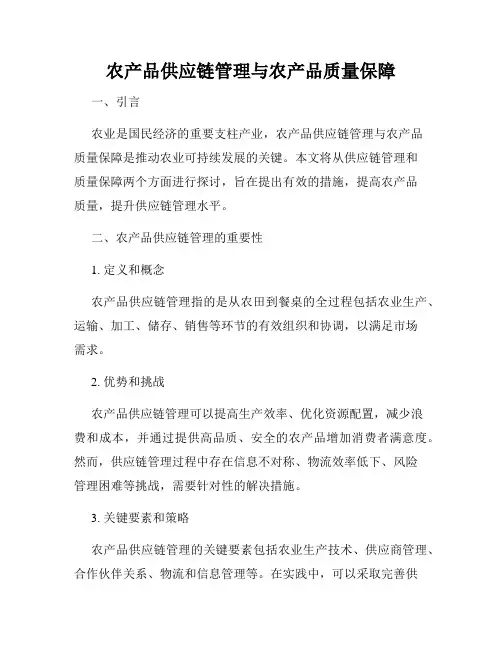
农产品供应链管理与农产品质量保障一、引言农业是国民经济的重要支柱产业,农产品供应链管理与农产品质量保障是推动农业可持续发展的关键。
本文将从供应链管理和质量保障两个方面进行探讨,旨在提出有效的措施,提高农产品质量,提升供应链管理水平。
二、农产品供应链管理的重要性1. 定义和概念农产品供应链管理指的是从农田到餐桌的全过程包括农业生产、运输、加工、储存、销售等环节的有效组织和协调,以满足市场需求。
2. 优势和挑战农产品供应链管理可以提高生产效率、优化资源配置,减少浪费和成本,并通过提供高品质、安全的农产品增加消费者满意度。
然而,供应链管理过程中存在信息不对称、物流效率低下、风险管理困难等挑战,需要针对性的解决措施。
3. 关键要素和策略农产品供应链管理的关键要素包括农业生产技术、供应商管理、合作伙伴关系、物流和信息管理等。
在实践中,可以采取完善供应链结构、建立信息化平台、优化运输与配送、加强品牌推广等策略来改善供应链管理。
三、农产品质量保障的重要性1. 定义和概念农产品质量保障是指通过科学、规范的生产管理和质量控制手段,确保农产品在生产、加工、运输、销售等环节中的质量达到国家标准和消费者需求。
2. 健全质量控制体系农产品质量保障需要建立健全的质量控制体系,包括产品质量监管法律法规制度的建设、质量标准化、质量检测与监测等方面的工作。
同时,还需要加强对农民的培训和引导,提高其质量意识和技术水平。
3. 风险预防与控制农产品质量保障需要加强风险预防与控制的措施,包括建立健全的风险评估与管理机制,加强对农产品质量安全的监测和排查,提高应急能力,确保农产品质量的安全可靠。
4. 消费者保护与品牌建设农产品质量保障需要注重消费者保护与品牌建设,加强对农产品质量标识和溯源体系的建设,提高消费者对农产品质量品牌的认知和信任度,增加品牌溢价能力。
四、农产品供应链管理与农产品质量保障的关系农产品供应链管理与农产品质量保障是相辅相成的,二者相互依存、相互影响。
农业行业农产品供应链管理在农业行业中,农产品供应链管理是至关重要的一环。
它涉及到从农田到餐桌的整个产品流通过程,包括农作物的种植、采摘、储存、运输以及最终的销售。
农产品供应链管理的有效实施,不仅可以提高农产品的质量和安全性,还可以降低成本、提升效率,并且更好地满足消费者对农产品的需求。
今天,我们将详细探讨农业行业农产品供应链管理的重要性以及其所面临的挑战。
一、农产品供应链管理的重要性农产品供应链管理对农业行业的发展至关重要。
首先,它能够确保农产品的质量和安全性。
农产品在种植和采摘过程中可能会受到土壤、气候和病虫害等因素的影响,供应链管理能够通过合理的种植管理和采摘标准,保证农产品的质量标准。
此外,供应链管理还可以确保农产品在储存和运输过程中不受损坏或污染,从而保证消费者的安全。
其次,农产品供应链管理有助于提高农业行业的效率和降低成本。
通过合理的物流规划和运输安排,可以缩短农产品从田间到市场的时间,降低运输成本。
此外,供应链管理还可以优化农产品的储存和库存管理,减少损耗和浪费,提高生产效率。
最后,农产品供应链管理还可以满足消费者对农产品的需求。
随着消费者对食品安全和质量的要求不断提高,供应链管理可以追踪农产品的来源和生产过程,提供有关农产品的信息和保证,增强消费者对农产品的信任和满意度。
二、农产品供应链管理的挑战农产品供应链管理在实践中面临着一些挑战。
首先是信息不对称的问题。
农业行业中涉及到各个环节的参与者众多,信息的流通和共享不够畅通,导致信息的不对称性。
这使得供应链的管理和协调变得困难,增加了风险和成本。
其次是农产品质量和安全监管的问题。
农产品的质量和安全是消费者关注的重点,政府和监管机构应加强对农产品的监管和检测。
然而,在一些地区或农场,监管机构和设备可能不足,导致农产品质量和安全问题的监管存在难度。
另外,农产品供应链中的物流和运输环节也存在一些挑战。
农产品的储存和运输需要符合一定的温度、湿度和卫生要求,但在一些地方,农产品物流设施和交通条件有限,难以满足这些要求。
1) A supply chain includes only the organizations directly involvedin supplying components needed for manufacturing.一个供应链仅包括直接参与提供所需的元件制造业的组织。
Answer: FALSE2) A supply chain consists of all parties involved, directly or indirectly, in fulfilling a customer request. Answer: TRUE供应链由所有各方,直接或间接参与,满足客户要求。
3) A supply chain could be more accurately described as a supply network or supply web.Answer: TRUE供应链可以更准确地描述为供应网络。
4) The objective of every supply chain is to maximize the overall value generated. TRUE每一个供应链的目的是生成的整体价值最大化。
5) The objective of every supply chain is to maximize the value generated for the manufacturing component of the supply chain. Answer: FALSE每一个供应链的目标是最大化为供应链的制造组件生成价值。
6) Every supply chain must include all 5 stages. Answer: FALSE每个供应链必须包括所有 5 个阶段。
7) The cycle view of a supply chain holds that the processes in a supply chain are divided into a series of activities performed at the interface between successive stages. Answer: TRUE供应链周期认为供应链流程分为一系列的活动上演在连续阶段之间的接口。
英语作文-农业科学研究和试验发展行业的农业产业链与供应链管理Agricultural science research and experimental development have become increasingly vital in the modern world, where food security and sustainable practices are at the forefront of global concerns. The agricultural industry chain and supply chain management play a crucial role in ensuring that the research and development efforts translate into tangible benefits for farmers, consumers, and the environment.The agricultural industry chain begins with the input suppliers who provide the seeds, fertilizers, and equipment necessary for crop production. These inputs are based on extensive research and development to ensure they are effective and sustainable. For instance, seed companies invest heavily in genetic research to develop drought-resistant and pest-resistant varieties, which are essential for maintaining crop yields in the face of changing climate conditions.Farmers are the next link in the chain, utilizing these inputs to produce crops. Their management practices are informed by agricultural science, which provides insights into soil health, water conservation, and crop rotation strategies. Precision agriculture technologies, such as satellite imagery and soil sensors, allow farmers to optimize their resources and reduce waste, leading to more efficient farming methods.Once the crops are harvested, they enter the processing phase, where they are cleaned, packaged, and prepared for distribution. This stage often involves another layer of research and development, particularly in developing packaging solutions that extend the shelf life of produce and reduce spoilage.The distribution of agricultural products is a critical component of the supply chain. Logistics companies work to ensure that the produce reaches markets efficiently and safely. This involves coordinating transportation, storage, and handling procedures that maintain the quality of the products. Innovations in transportation, such as refrigerated trucks and containers, have been instrumental in reducing food loss during transit.Retailers and food service providers are the final links in the industry chain, delivering the agricultural products to consumers. They rely on supply chain management to maintain a steady flow of products, manage inventory, and respond to consumer demand. Research in consumer behavior and market trends helps these businesses to stock products that meet the needs and preferences of their customers.Throughout the entire agricultural industry chain, supply chain management is essential. It involves planning, implementing, and controlling the flow of agricultural goods and services from the point of origin to the point of consumption. Effective supply chain management ensures that the right products are available at the right time, in the right quantities, and at the right cost.In conclusion, the integration of agricultural science research and experimental development with the agricultural industry chain and supply chain management is critical for the advancement of agriculture. It ensures that scientific breakthroughs are effectively applied in the field, leading to improved crop yields, sustainable practices, and ultimately, food security for the growing global population. The collaboration between researchers, farmers, processors, distributors, and retailers is what makes this integration successful, creating a resilient and responsive agricultural system. 。
农产品供应链英语English:The agricultural sector plays a critical role in the global economy, and the efficient management of the agricultural supply chain is essential for the success of this industry. The agricultural supply chain encompasses a series of interconnected activities that involve the production, harvesting, processing, packaging, transportation, and distribution of agricultural products. It begins with the cultivation of crops or the raising of livestock, where farmers employ various techniques to optimize yields and ensure the quality of the produce. Once the products are ready for harvest, they undergo processing, which involves cleaning, sorting, grading, and possibly transforming the raw materials into value-added products. Packaging is then done to protect and preserve the products during transportation and storage. The next step is transportation, where different modes of transport are used to move the products from the production site to the processing facilities or directly to the consumers. Finally, distribution involves the logistics of getting the products to the end-users, either through wholesalers, retailers, or directly to consumers.The agricultural supply chain faces various challenges that require efficient management. One of the challenges is the seasonality of agricultural production, as different crops and livestock have specific growth and harvest periods. Managing the supply chain to ensure a constant and stable flow of products throughout the year can be demanding. Another challenge is the perishability of agricultural products, which requires careful handling and transportation to maintain their quality and freshness. Additionally, the agricultural supply chain is influenced by external factors such as weather conditions, pests, diseases, and market fluctuations, which can impact production levels and prices.Efficient management of the agricultural supply chain is crucial to maximize profits, minimize waste, and ensure the availability of high-quality products for consumers. This involves optimizing production processes, improving storage and preservation techniques, implementing effective inventory management systems, and establishing reliable transportation networks. Coordinating and collaborating with various stakeholders, including farmers, processors, distributors, and retailers, is essential to achieve seamlessflow and coordination of activities along the supply chain. Furthermore, technological advancements, such as the use of data analytics, automation, and blockchain, can greatly enhance transparency, traceability, and efficiency in managing the agricultural supply chain.中文翻译:农产品供应链在全球经济中起着至关重要的作用,农业供应链的高效管理对该行业的成功至关重要。
Innovation and Future Directions of Supply Chain Management in US Agri-Food美国农业食品供应链管理的创新与未来导向翻译作者:伊利诺斯大学香槟分部农业与消费经济学部Randall E. Westgren翻译:百事有我美国的农业食品业中,目前已有很多供应链管理企业间战略创新涌现。
这些旨在寻找新型的组织形式以取代传统的纵向相关的企业关系的试验倾向于“本地化”而非“全球化”。
其他企业没有在大范围一致地模仿的模式,就被认为就是本地化的。
理论学者对这种模仿所用的术语就是“模仿同构”。
主要结论就是在结构化变革的时期,新的政策形式之后会出现一个调查的过程。
其中不同的形式会被测试、评价,有的最终会被采用。
最成功的那些形式会被模仿,且随着时间推进,他们变成了主要的或者唯一的政策形式——同构化。
显然,我们正在经历美国的农业产品许多相关行业的试验和评价过程。
有的人会认为“所有的行业都会走上美国家禽产业的道路”,即在整合者和生产者之间有着高度同构化的合约,但非正式的实证研究显示,在同一个行业内撰写的合约也有显著的差别。
另外,有各种各样治理结构的战略联盟,从单一的供应商合约到非股权的合资企业也可以作为证据。
我们从试验和评价到任何类似的定居还有很多年。
然而,当前也有一个清晰的趋势,供应链管理的垂直性会从供应链中企业间单链接的策略拓展到多链接策略。
现货市场正在被不断快速地替换以维持在多个链接之间产品特征和信息流动。
供应链管理定义供应链管理不缺各种定义,但大部分都通常局限于产品流和物流。
这是由供应链语言在生产/运营管理和物流中的起源引起的。
虽有风险在这些不同的定义上增加了不和谐的声音,我仍会提供以下这个解释。
供应链管理有三个要素:1.产品流——生产、库存和物流;2.信息流——在供应链不同链接之间传递价值信号;以及3.治理结构——批准企业间的战略决定。
这三个要素必在供应链管理中出现。
外文翻译原文Agri-Supply Chain ManagementMaterial Source:/en/Document.923.pdfAuthor: Jan van RoekelThis section describes three cases of cross-border supply chain development in the food industry. Each case highlights background, objectives, approach, and cooperation and the development process.The Ghanaian Processed Fruit Supply ChainBackground:Imports of vegetables, fruits, nuts and cereals from developing countries into the European Union amounted to more than €8 billion in 1999 (Buurma et al., 2001). Developing country producers face increasing difficulties in meeting international standards for quality and food safety. Moreover, many multinational food chains are creating and implementing their own standards for quality and safety. Smallholder producers, due to their limited resources, are at a disadvantage in accommodating such requirements for quality and safety guarantees and certification.Objectives:The company Blue Skies was formed in 1997 and started to produce processed tropical fruits for the international market in Ghana early 1998. Shortly thereafter, the company initiated a supply chain management project aimed at improving the quality of its processed fruit.One task was to take a hard look at the organization of the processed fruit supply chain. The result of this analysis was the company’s decision to move some processing activities to Ghana, to the benefit of both the enterprise and the local community (in the form of jobs). The move brought more value-added activities to the country, and the quality of the product was also improved, as the processing was brought closer to the growing area.Approach:Blue Skies initiated and guided the project development process, translating European market opportunities into a strategic business model for the Ghanaian supply chain partners. Quality of processed fruit and the entire production process is now guaranteed through an integrated approach to supply chain management ‘from farm to fork’. Some smallholders, large-scale producers and their out-growers supply fresh fruit to the processing factory.Noteworthy outputs of the project include the following:- development and implementation of a trusted third-party certification scheme by all chain partners within 24 months- added value to raw materials in the country of origin- substantial export flow to upper-end market segments in various European countries - signed agreement of fruit suppliers on farm audits and approved pesticides for each crop- staff of the processing factory (250 local employees) trained to assemble, prepare and dispatch fruit according to HACCP principles- development of a quality manual for certificationCooperation and the development process:The food processing company has developed close links with a broad range of public and private partners. Each makes its own contributions to the chain project: providing help and assistance to farmer-suppliers in the form of agricultural education and advice, developing a sound transport and logistics infrastructure, developing resilient and suitable packaging processes and implementing quality management systems.The public partners and international centers of expertise participated in the design of the project and implementation of the code of conduct on good agricultural practices with the fruit suppliers and the processing factory.South Africa–The Netherlands’ Fresh Fruit Supply ChainBackground:South Africa’s fresh fruit industry has experienced tough times recently due to the 1997 deregulation of the export system. Competition increased and prices dropped. These developments prompted the stakeholders of the sector to undertake a feasibility study on optimization of the cold fruit supply chain between South Africa and the Netherlands, a major trading partner. The study was conducted in 2000 with farmers, fruit cooperatives, private companies and knowledge institutes from both countries. It found that lack of accurate information on logistics flows and quality aspects of the fruit was a problem common among all the chain partners (from farmer to retailer). To address the problem, the partners initiated an information system development project to enable them to monitor product flow from country of origin to market.Objectives:The first objective was to assess the potential benefits and costs of an integrated supply chain information system. The South African information and communication technology provider Paltrack had already developed a system used bySouth African authorities to record the quantity of all fruit exported from the country. The aim of the fresh fruit supply chain pilot project was to extend this information system with logistics and quality data for fruit from South Africa destined for the Netherlands.Approach:Three existing distribution chains for fresh fruit exports from South Africa to the Netherlands served as models in the project. Participating research institutes gathered information from these private companies via interviews. Questions focused on how information on logistics and produce quality was exchanged from farmer to retailer and on specific requirements for additional information on these two aspects. The researchers analyzed the three distribution chains separately to ensure confidentially of chain information.A number of project outputs are worthy of note: World Bank PaperCross-Border Agri Supply Chain Management- Generic modeling of a supply chain information system for fruit which can be used or adapted by other supply chains- Ideas for improving information exchange between chain partners- Suggestions for farmer-level improvements concerning harvest and post-harvest activities- Suggestions for cooperative/exporter-level improvements regarding quality-control practices, feedback to farmers and standardization, for example, of shipping pallets- Suggestions for government-level improvements such as investments in fruit sector infrastructure (packing houses, transport, harbor), quality control and research facilities- Dissemination of results in workshops, conferences, publications and Web sites Cooperation and the development process:Both private and public parties participated in the project. Some of the private companies involved were motivated to participate because their competitor did so or to make sure that they did not miss out on market advantages or innovations. coordinator responded to information requests and solved problems such as misunderstandings and disagreements among project participants. The committee’s task was to approve project activities, monitor project performance and act on new developments within the supply chain. The participants apparently valued these meetings, since most were present at all. The atmosphere of the meetings was open and positive and even competitors chatted amicably before and after the official business. Because participants had signed clear agreements onconfidentiality, intellectual property rights and information dissemination to the ‘outside world’, no significant problems arose concerning thes e issues.Public sector contributions reflected the two countries’ commitment to private-sector development and, there with, to economic growth on both sides.Fresh Food Supply Chain in ThailandBackground: Thai consumers are spending an increasing proportion of their income on fresh fruits and vegetables, the percentage having risen from 19% in 1985 to 24% in 1993. Most produce is sold in traditional market outlets, in ambulant street trade and in the so-called ‘wet markets’. Overall, 5% of sales are made through supermarkets, although this proportion has already reached 50% in the capital Bangkok. In recent years, international retailers World Bank PaperCross-Border Agri Supply Chain Management like 7-Eleven, Royal A hold, Tesco, Makro, Carrefour and Sains burry have established supermarkets especially to serve Thailand’s urban conglomerates. In 1996, Royal A hold established a joint venture with the Thai Central Retail Corporation and started to operate more than 30 TOPS supermarkets (most of which are located in Bangkok and Chiangmai). From the start, TOPS proliferated itself as the supermarket chain for quality fresh food.Objectives: In 1998, TOPS began a supply chain project aimed at providing Thai consumers high-quality, safe, fresh produce with reliable availability at affordable prices. To achieve that goal, however, the supply chain faced a number of problems. For example, roughly 250 suppliers were delivering perishables directly to the backdoors of 35 stores at least three times a week. This meant high handling costs, significant post-harvest and shrinkage losses and low service levels (meaning that produce was often out of stock).TOPS enlisted public-sector assistance and started the project with four objectives: raising the level of service within the perishables supply chain; reducing lead times and post-harvest losses and shrinkage; improving quality and safety of produce by developing preferred supplier relationships and introducing good agricultural practices and a certification scheme; and raising the knowledge and awareness of employees and professionals in the local food industry through on-the-job training (e.g., in HACCP) and a mini-MBA program.Approach: The TOPS supply chain has thus far focused on delegating value-added activities and selecting preferred suppliers. Since at the start of the project none of the fresh-goods suppliers performed the value-added functions required (e.g., sorting, packaging), the project decided to build a fresh distributioncenter that would also perform productive functions like quality control, packaging and processing. This value-added center was a complete green-field operation located on the edge of Bangkok. The center served as the locus for the project’s work to improve supply chain performance for perishables.A number of noteworthy results were achieved:- Establishment of the fresh distribution center in Bangkok- Reduction of the number of preferred suppliers from 250 to 60 in the first half of 2001, with 40 out of the 60 certified by the Department of Agriculture (DOA) and carrying the DOA label- Provision of training to quality control managers at the TOPS distribution center and in the stores, with the service level increasing to 98%- Development of a value-chain analysis model- Development of a model for lead-time reduction- Reduction of the lead-time from farm-to-fork from 68 hours to less than 24 hours Cooperation and the development process: Between 1998 and 2002, the emphasis of the supply chain development strategy gradually changed from chain optimization to integral chain care. Chain partners established cross-border public-private alliances with international research institutes and ministries of agriculture to find ways to increase food safety assurance and improve certification, as well as to strengthen research and education capacity about and within the food chain. The project became affiliated with the Department of Agriculture’s certification program to increase public awareness and gain trust and to build the image of a reliable and responsible retailer. The main challenges the project encountered concerned intercultural barriers. For example, the preferred supplier program ran up against the traditional Thai system of personal networks in agricultural trade. Buyers and suppliers customarily maintain personal relationships to create stability and continuity in trade, despite the fact that this is not always economically efficient. Consequently there has been some resistance to optimization of the supplier network. However, the project has helped to convince many participants that the implementation of the preferred supplier program is required to improve the supply of perishables. Also, the chain partners sometimes experienced intercultural communication barriers. This resulted in delays and postponements but also contributed to a growing mutual understanding.译文农产品供应链管理资料来源: /en/Document.923.pdf作者:杰.范.洛克尔这部分描述了三个跨国的食品生产供应链的案例。